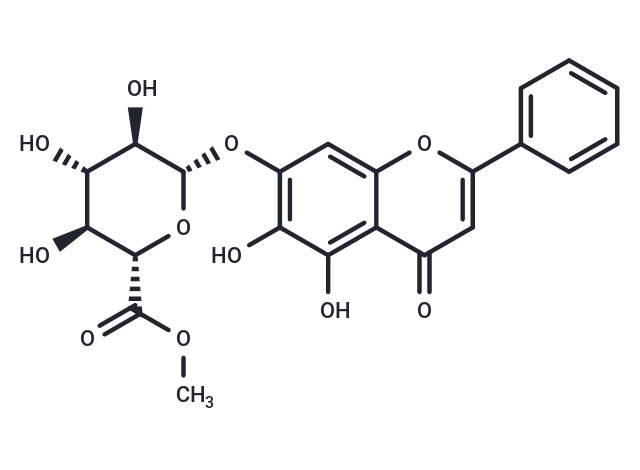Shopping Cart
Remove All Your shopping cart is currently empty
Your shopping cart is currently empty
Baicalin methyl ester shows inhibitory effects on the Avian Myeloblastosis Virus reverse transcriptase (AMV-RT).

| Pack Size | Price | USA Warehouse | Global Warehouse | Quantity |
|---|---|---|---|---|
| 1 mg | $50 | In Stock | In Stock | |
| 5 mg | $138 | In Stock | In Stock | |
| 10 mg | $198 | In Stock | In Stock | |
| 25 mg | $347 | In Stock | In Stock | |
| 1 mL x 10 mM (in DMSO) | $161 | In Stock | In Stock |
| Description | Baicalin methyl ester shows inhibitory effects on the Avian Myeloblastosis Virus reverse transcriptase (AMV-RT). |
| In vitro | One hundred-ninety flavonoids and 75 alkaloids were studied for their inhibitory effects on the Avian Myeloblastosis Virus reverse transcriptase (AMV-RT) by using (rA) n-p(dT) <12-18> or (rC) n-p(dG) <12-18> as a template-primer. Of the flavonoids tested, 6-hydroxyluteolin (50), pedalitin (52), 6-hydroxykaempferol (109) and quercetagetin (129), were the most potent inhibitors with IC50?:10 μM. Five other flavonoids, baicalein (19), Baicalin methyl ester (23), scutellarein (33), myricetin (126) and gossypetin (130), gave IC50 between 35 and 200 μM. The kinetic studies on 50, 126 and 130 gave the inhibitory constants ki of 10, 94 and 90 μM, respectively, with respect to the substrate and 5, 200 and 100 μM, respectively, with respect to the template-primer. Structurally different alkaloids such as isoquinoline, indol, steroidal, quinolizidine, pyrrolizidine, pyridine and imidazole alkaloids were also investigated for the activity and berberine type alkaloids were shown to have a strong inhibitory activity. |
| Molecular Weight | 460.39 |
| Formula | C22H20O11 |
| Cas No. | 82475-03-4 |
| Smiles | COC(=O)[C@H]1O[C@@H](Oc2cc3oc(cc(=O)c3c(O)c2O)-c2ccccc2)[C@H](O)[C@@H](O)[C@@H]1O |
| Relative Density. | 1.631 g/cm3 (Predicted) |
| Storage | Powder: -20°C for 3 years | In solvent: -80°C for 1 year | Shipping with blue ice/Shipping at ambient temperature. | ||||||||||||||||||||||||||||||
| Solubility Information | DMSO: 45 mg/mL (97.74 mM), Sonication is recommended. | ||||||||||||||||||||||||||||||
| In Vivo Formulation | 10% DMSO+40% PEG300+5% Tween 80+45% Saline: 2 mg/mL (4.34 mM), Sonication is recommended. Please add the solvents sequentially, clarifying the solution as much as possible before adding the next one. Dissolve by heating and/or sonication if necessary. Working solution is recommended to be prepared and used immediately. The formulation provided above is for reference purposes only. In vivo formulations may vary and should be modified based on specific experimental conditions. | ||||||||||||||||||||||||||||||
Solution Preparation Table | |||||||||||||||||||||||||||||||
DMSO
| |||||||||||||||||||||||||||||||
| Size | Quantity | Unit Price | Amount | Operation |
|---|

Copyright © 2015-2025 TargetMol Chemicals Inc. All Rights Reserved.